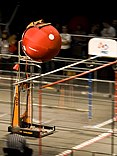
FIRST Frenzy: Raising the Bar was the 2004 game for the FIRST Robotics Competition. The game included elements from previous years' games, including mobile goals, "capping" goals with large inflatable balls, and others. In Raising the Bar, teams could score by having their human player score purple balls in any of the goals, capping the goals with a multiplier ball, or hanging their robot suspended from the 10-foot (3.0 m) high 'chin up bar'. In the qualifying matches, Teams competed in 2-member randomly generated alliances. In the elimination rounds, 3-member alliances competed against each other with one team sitting out each match. The alliance that won two matches advanced in the tournament.

A billiard table or billiards table is a bounded table on which cue sports are played. In the modern era, all billiards tables provide a flat surface usually made of quarried slate, that is covered with cloth, and surrounded by vulcanized rubber cushions, with the whole thing elevated above the floor. More specific terms are used for specific sports, such as snooker table and pool table, and different-sized billiard balls are used on these table types. An obsolete term is billiard board, used in the 16th and 17th centuries.
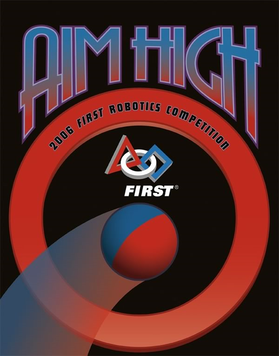
Aim High was the 2006 game for the FIRST Robotics Competition. The competition involved teams competing to gain points by delivering balls into goals and positioning their robots in certain positions on the playing field. The teams took it in turn to provide defense and attack.
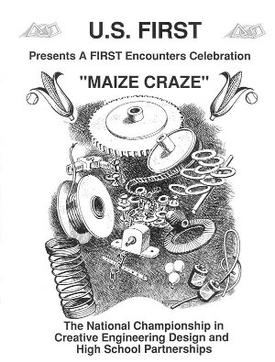
Maize Craze was the game in the inaugural year, 1992, of the FIRST Robotics Competition. This game was played by four individual robots trying to collect tennis balls into their starting base. An impediment to the robots was that the entire playing field was covered in a layer of corn 1-2 inches thick.

Tower Power was the 1994 game for the FIRST Robotics Competition.

Ramp n' Roll was the 1995 game for the FIRST Robotics Competition.
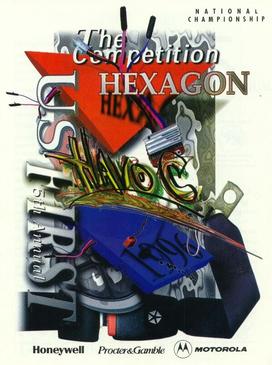
Hexagon Havoc was the 1996 game for the FIRST Robotics Competition. Seeding games of 1-on-1-on-1 were played double-elimination to determine the teams for the finals rounds. In the finals, robots played 1-on-1 in a best 2 out of 3.

Toroid Terror was the 1997 game for the FIRST Robotics Competition. This was the first year that FRC had a regional event outside its origins in New Hampshire; in addition to Manchester, regionals were held in Chicago and New Brunswick, New Jersey, as well as the championship event at a complex set up in the Epcot parking lot. It was also the first year in which the scoring object was not a ball.

Ladder Logic was the game for the 1998 FIRST Robotics Competition.
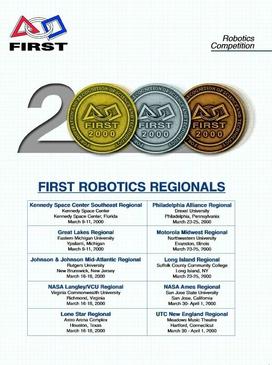
Co-Opertition FIRST was the 2000 game for the FIRST Robotics Competition.
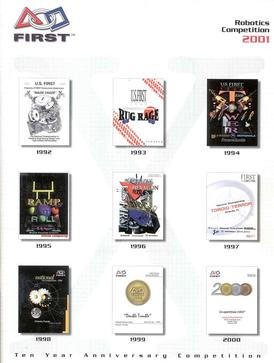
Diabolical Dynamics was the 2001 game for the FIRST Robotics Competition.

In the 2007-2008 FIRST Tech Challenge robot competition, Quad Quandary is the first challenge theme replacing the former FIRST Vex Challenge, with similar general rules regarding the specifications of the robot and the game play. Unlike the previous challenge, Hangin'-A-Round, Quad Quandary makes use of small rings and movable goal posts.

Half-Pipe Hustle was the first official FIRST Vex Challenge (FVC) game, taking place in 2005–2006. In this challenge, robotics teams built robots from the Vex design kit to compete in competitions across the United States and in other nations, in matches consisting of a 45-second autonomous period, followed by a 2-minute driver control period in which the robots are controlled by team drivers using remote controls.

Lunacy is the game for the 2009 FIRST Robotics Competition. Announced on January 3, 2009, the name and some of the features of the game honor the 40th anniversary of the first human mission to the Moon. It is FRC's 18th game. This is the first FRC competition to use the cRIO Mobile Device Controller control system from National Instruments. The driver station introduced for 2009 was the Kwikbyte DS, which was replaced in 2010 by the Classmate PC.

Hot Shot! is the robotics competition event in the 2009-2010 FIRST Tech Challenge. Two teams compete to score points by depositing whiffle balls into designated areas.
FIRST Stronghold was the 2016 FIRST Robotics Competition game. The game was played by two alliances of up to three teams each, and involves breaching the opponents’ defenses, known as outer work as well as capturing their tower by first firing "boulders" at it, and then surrounding or scaling the tower using a singular rung on the tower wall. Points were scored by crossing elements of the tower's outer works, shooting boulders into the opposing tower's five goals in order to lower the tower strength, and by surrounding and scaling the tower.
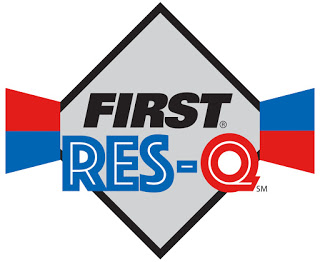
FIRST Res-Q, released on September 8, 2015, is the 2015–2016 robotics competition for FIRST Tech Challenge. In the competition, two alliances, each consisting of two teams, compete to climb a mountain and score debris in alliance specific goals. FIRST Res-Q is the eleventh FTC challenge game.
VEX Robotics is a robotics program for elementary through university students and a subset of Innovation First International. The VEX Robotics competitions and programs are managed by the Robotics Education & Competition Foundation (RECF). In April 2018, VEX Robotics Competition was named the largest robotics competition in the world by Guinness World Records.

FIRST Steamworks, stylized as FIRST STEAMworks, was the FIRST Robotics Competition game for the 2017 season. As in past games, two alliances of three individual teams and their robots compete on a field to score "match" point to win the game and ranking points to advance to playoff rounds. The game has a steampunk theme and teams are required to shoot wiffle balls which represent fuel into a simulated boiler which transfers the generated steam into an airship in the middle of the field. Each alliance has one airship, which they pressurize with steam from the boiler and load with plastic gears from the field. At the end of the match, robots can climb and hang on team-supplied ropes attached to the airship for additional points.

Rapid React, stylized as RAPID REACT and officially known as Rapid React presented by The Boeing Company for sponsorship reasons, is the FIRST Robotics Competition (FRC) game for the 2022 season. The game is themed around transportation as part of the FIRST-wide FIRST Forward theme for 2021-2022.




















